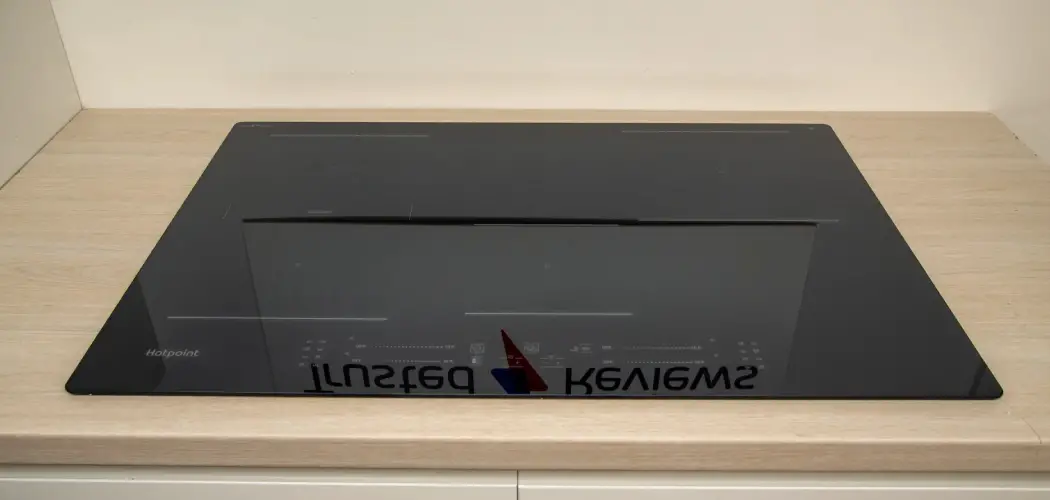Protecting your induction cooktop from scratches is essential for maintaining its sleek appearance and prolonging its lifespan. Induction cooktops feature smooth glass surfaces that can easily become scratched or damaged if not handled with care.
Fortunately, there are several simple steps you can take to prevent scratches and keep your cooktop looking like new.
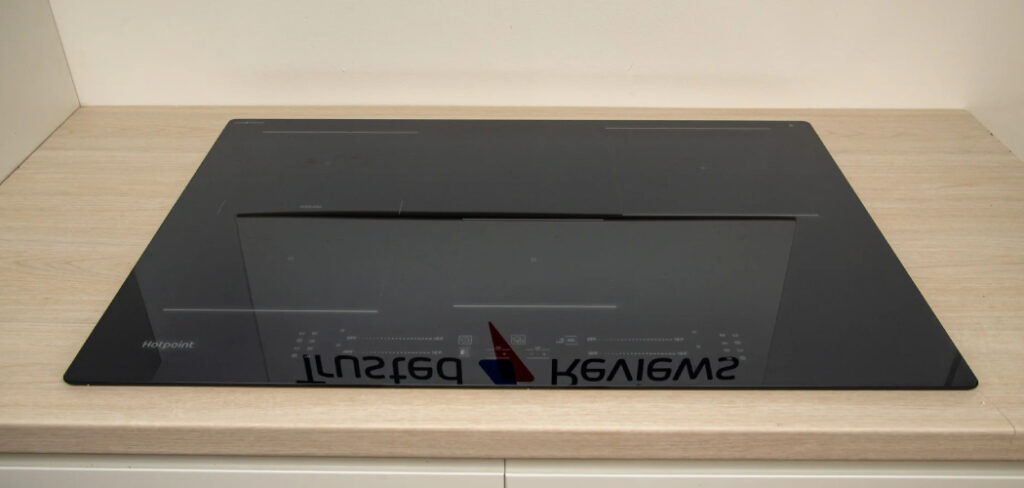
From using the right cookware to employing protective measures during cooking and cleaning, understanding how to protect induction cooktop from scratches ensures that it remains a stylish and functional centerpiece of your kitchen for years to come.
In this article, we’ll explore ten effective strategies for protecting your induction cooktop from scratches, allowing you to enjoy worry-free cooking and effortless maintenance.
The Importance of Protecting Induction Cooktops
The induction cooktop, a marvel of modern kitchen technology, marries the elegance of sleek design with the efficiency of cutting-edge cooking performance. However, its very allure— that glossy, seamless glass surface— is also its vulnerability.
Preserving this surface’s integrity goes beyond mere aesthetic appeal; it directly impacts the cooktop’s functionality and longevity. Scratches can disrupt the magnetic field essential for induction cooking, affecting the efficiency with which it heats cookware and, consequently, the uniformity of cooking.
More than that, the accumulation of scratches and damage can considerably diminish the value of your kitchen’s investment over time. Thus, taking measures to protect your induction cooktop isn’t just about maintaining its good looks but ensuring it continues to operate at pinnacle performance for years to come.
Understanding Induction Cooktop Surfaces
To effectively protect your induction cooktop from scratches, it’s crucial to understand the material it’s made of and why it’s susceptible to damage. The surface of an induction cooktop is typically crafted from a durable, heat-resistant glass-ceramic compound.
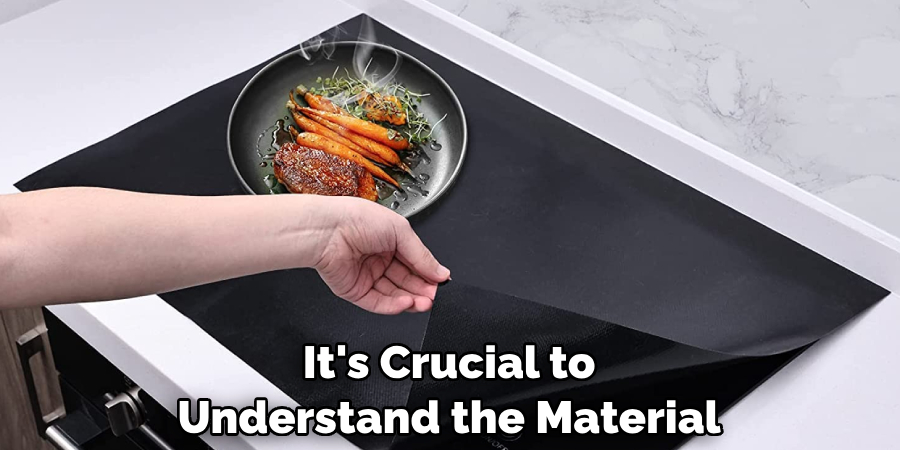
This material is specifically chosen for its ability to withstand the rapid heating and cooling associated with induction cooking while providing a smooth, flat surface necessary for efficient magnetic conductance. However, despite its resilience to thermal shock, glass-ceramic is prone to scratches and abrasions from rough cookware, abrasive cleaning materials, or even particles like salt and sugar trapped between the cookware and the cooktop.
Recognizing the strengths and vulnerabilities of your induction cooktop’s surface is the first step in adopting practices that will keep it scratch-free and functional for the long haul.
Materials Used in Induction Cooktop Surfaces
The main material used in the construction of induction cooktop surfaces is a glass-ceramic composite. This innovative material combines the thermal durability of ceramic with the smooth, transparent properties of glass. Glass-ceramic is renowned for its ability to withstand extreme temperature changes without cracking, an essential feature for the rapid heating and cooling cycles of induction cooking.
Additionally, this material is chosen for its excellent thermal conductivity, ensuring that heat is efficiently transferred from the cooktop to the cookware. Another critical characteristic of glass-ceramic is its low thermal expansion, which prevents the surface from deforming under high temperatures.
Despite these impressive properties, glass-ceramic’s vulnerability to physical abrasions and scratches necessitates careful handling and maintenance to preserve the cooktop’s functionality and aesthetic appeal.
Vulnerability of Induction Cooktop Surfaces
Despite the impressive durability and innovative design of glass-ceramic induction cooktops, their surfaces are inherently vulnerable to certain types of damage.
The most common form of wear these cooktops face is scratching, which can occur through everyday cooking and cleaning practices. Scratches may not only mar the sleek, shiny appearance of the cooktop but can also interfere with its efficiency.
The smooth surface of an induction cooktop is crucial for the effective transfer of electromagnetic energy to the cookware. When this surface is compromised by scratches or abrasions, it can lead to uneven cooking and potentially reduce the lifespan of the cooktop.
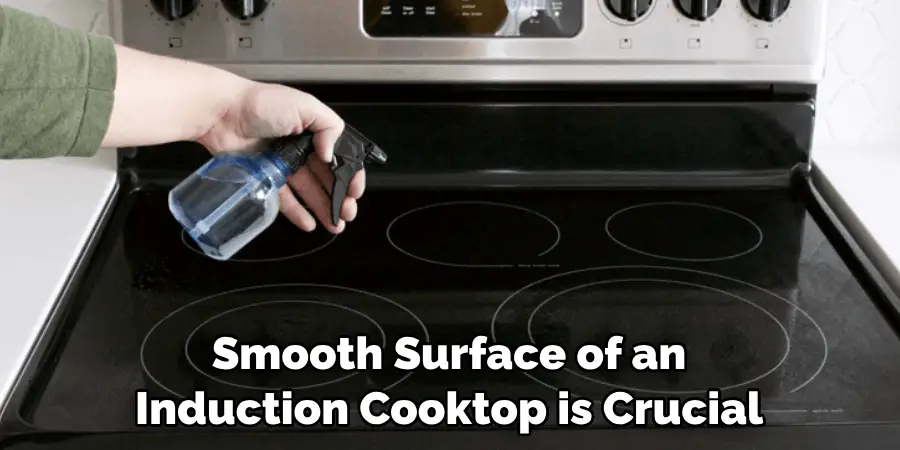
Additionally, deeper scratches can become harboring places for dirt and grime, making the cooktop more challenging to clean and potentially leading to further damage over time. Understanding these vulnerabilities is key to adopting the right strategies for cooktop care and maintenance.
10 Methods How to Protect Induction Cooktop from Scratches
1. Choose the Right Cookware:
Opt for cookware specifically designed for use with induction cooktops. Look for pots and pans with smooth, flat bottoms made from materials that are compatible with induction cooking, such as stainless steel, cast iron, or enameled steel.
Avoid using cookware with rough or uneven bottoms, as they can scratch the glass surface of the cooktop. Additionally, ensure that the cookware is free of any sharp edges or rough spots that could potentially damage the cooktop.
Cookware made from non-magnetic materials, such as aluminum or copper, will not work on an induction cooktop unless they have a layer of magnetic material bonded to the bottom. This is because induction cooktops use electromagnetic currents to heat up the pan itself, rather than relying on direct heat from a flame or heating element.
2. Use Cookware Protectors:
To provide an extra layer of protection between your cookware and the induction cooktop, consider using cookware protectors or silicone mats. These thin, heat-resistant pads can be placed on the cooking surface before placing your pots and pans, preventing direct contact and reducing the risk of scratches.
Silicone mats are also easy to clean and can be reused multiple times, making them a convenient and cost-effective solution for protecting your cooktop. While cookware protectors may not be necessary for all types of induction cooktops, they can be particularly useful for glass or ceramic surfaces that are more susceptible to scratches.
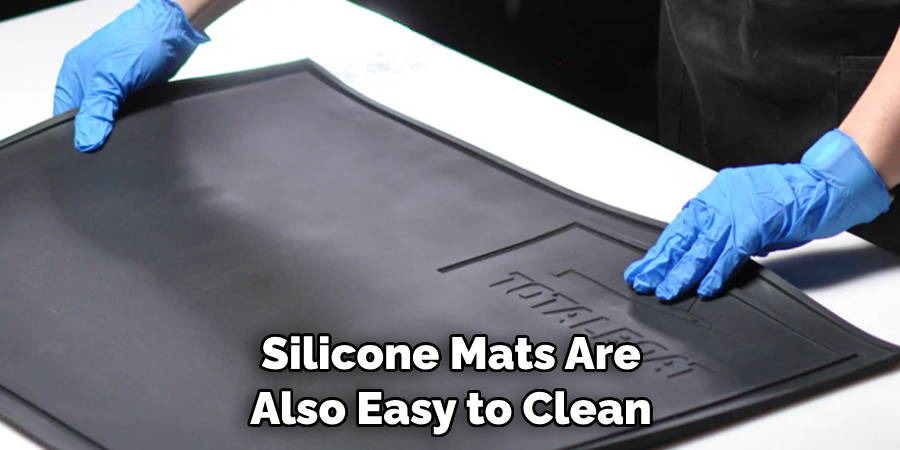
3. Avoid Sliding Cookware:
When moving pots and pans across the surface of the induction cooktop, avoid sliding them, as this can scratch the glass surface. Instead, lift cookware off the cooktop and gently place it down in the desired location. If you need to reposition cookware while cooking, use pot holders or oven mitts to lift and move it without scratching the cooktop.
Additionally, choosing the right cookware is crucial for maintaining your induction cooktop. Opt for pots and pans with a flat, smooth bottom to prevent scratches on the glass surface.
Stainless steel, cast iron, and enameled steel are all great options for induction cooking. Avoid using copper or aluminum cookware as they may not work effectively on an induction cooktop and can potentially scratch the surface.
In addition, it is important to regularly clean your cooktop to prevent any build-up of dirt or residue that can cause scratches over time. Use a soft cloth or sponge with a mild cleaner specifically designed for glass cooktops. Avoid using abrasive cleaners or scouring pads, as these can also damage the surface of your induction cooktop.
4. Clean Regularly:
Keeping your induction cooktop clean is essential for preventing scratches and maintaining its appearance. Wipe down the cooktop after each use with a soft, damp cloth or sponge to remove any spills or food residue.
Avoid using abrasive cleaners or scrubbing pads, as they can scratch the glass surface. Instead, use a gentle cleaning solution specifically formulated for glass cooktops, and follow the manufacturer’s instructions for best results.
Regular cleaning of your induction cooktop will also ensure that the burners and heating elements function properly. Any buildup or residue on these components can affect their performance, leading to uneven cooking or even failure. Additionally, regular cleaning can help prevent staining and discoloration of the glass surface.
5. Remove Spills Promptly:
Spills and food residue left on the cooktop can become hardened and difficult to remove over time, increasing the risk of scratches. To prevent this, clean up spills and messes promptly using a soft, damp cloth or sponge.
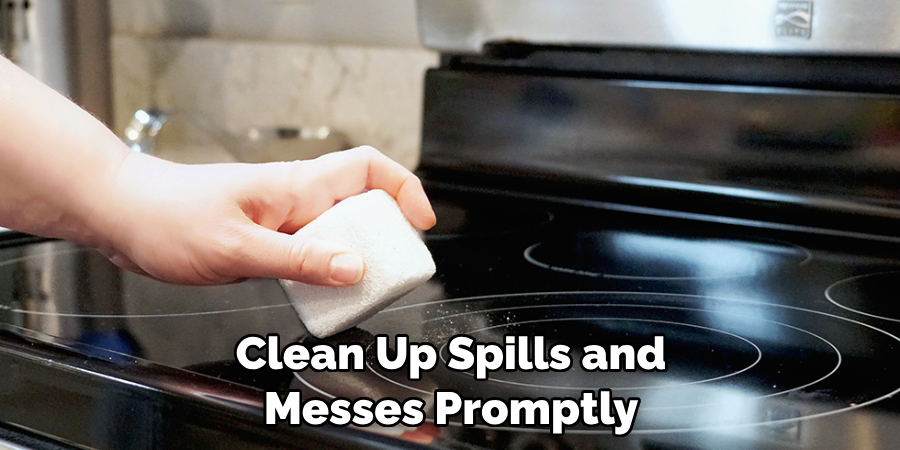
For stubborn stains or burnt-on residue, you can use a glass cooktop cleaner or a paste made from baking soda and water to help loosen the debris before wiping it away.
It’s important to always use gentle and non-abrasive cleaning methods to avoid damaging the surface of your cooktop. Though a cooktop may look tough, it is still susceptible to scratches and other damages.
6. Avoid Dropping Heavy Objects:
Be cautious when handling heavy pots and pans near the induction cooktop, as dropping them onto the surface can cause scratches or cracks. Always lift cookware carefully and avoid banging it against the cooktop or other hard surfaces.
When storing cookware, avoid stacking heavy items on top of each other, as this can also lead to scratches or damage. Instead, store cookware in a designated cabinet or shelf to keep it safe and secure.
It’s also important to be mindful of the weight capacity of your cooktop. Most induction cooktops have weight limits for each cooking zone, so exceeding these limits can cause damage to the surface. Be sure to check your cooktop’s manual for the weight capacity and use caution when placing heavy objects on the cooktop.
7. Use Protective Covers:
When not in use, consider covering your induction cooktop with a protective cover or lid to prevent scratches and other damage. Many manufacturers offer custom-fit covers designed specifically for their cooktop models, which provide a secure and snug fit.
Alternatively, you can use a large, flat cutting board or silicone mat as a makeshift cover to protect the cooktop from scratches caused by accidental bumps or scratches.
Protecting your cooktop from spills and stains is also important. To avoid any potential damage, it’s recommended to wipe down the surface after each use with a soft cloth or sponge and a mild detergent. Avoid using harsh chemicals or abrasive cleaners, as they can cause discoloration or scratches on the cooktop surface.
8. Trim Cookware Handles:
Some cookware handles may have sharp edges or rough surfaces that can scratch the induction cooktop if they come into contact with it. To prevent this, trim or file down any rough edges or protrusions on the handles of your pots and pans.
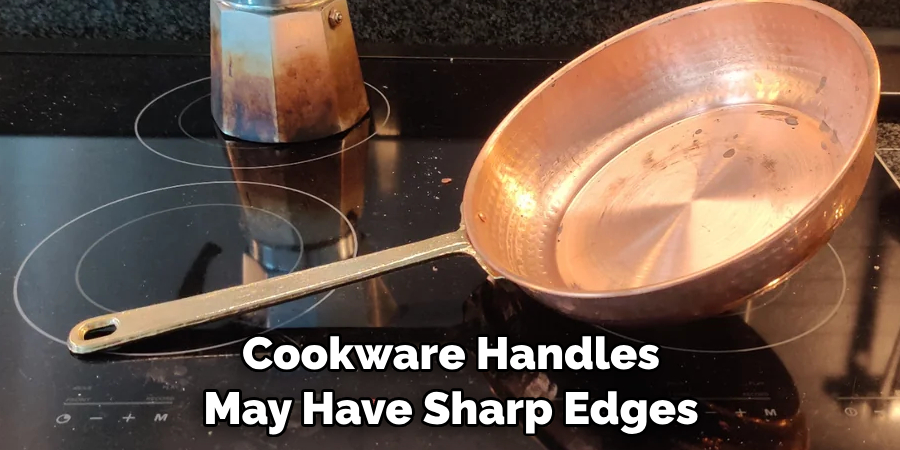
You can also use silicone handle covers or sleeves to cushion and protect the handles, reducing the risk of scratches and damage to the cooktop. While this may seem like a minor step, it can greatly extend the life of your cookware and prevent costly repairs or replacements.
Additionally, you may want to consider investing in induction-friendly cookware with sleek and smooth handles that are specifically designed for use on induction cooktops.
This will not only ensure that your cookware is safe for use on the cooktop, but also make it easier to clean and maintain.
Furthermore, proper handling and care of your cookware can also help prevent scratches on the cooktop. Always lift and move pots and pans instead of dragging or sliding them across the surface. This will not only prevent scratches but also keep your induction cooktop looking shiny and new.
9. Avoid Using Abrasive Cleaning Tools:
When cleaning your induction cooktop, avoid using abrasive cleaning tools such as steel wool pads or abrasive scrubbing brushes, as they can scratch the glass surface. Instead, opt for soft, non-abrasive cleaning cloths or sponges that won’t scratch or damage the cooktop.
If you encounter stubborn stains or residue, use a gentle glass cooktop cleaner or a paste made from baking soda and water to help lift and remove the debris without scratching the surface. Therefore, it is important to always check the cleaning instructions provided by the manufacturer before using any cleaning products on your induction cooktop.
While some cooktops may be able to withstand harsher cleaning methods, it is better to err on the side of caution and use gentler methods to protect the longevity and appearance of your cooktop.
10. Regular Maintenance:
Performing regular maintenance on your induction cooktop can help prevent scratches and keep it looking like new. Check the cooktop regularly for signs of wear or damage, such as scratches, cracks, or chips, and address them promptly to prevent further deterioration.
Lubricate any moving parts, such as control knobs or hinges, to ensure smooth operation and prevent scratches caused by friction.
By taking proactive steps to protect and maintain your induction cooktop, you can enjoy years of scratch-free cooking and a beautiful, pristine appliance in your kitchen. To make maintenance easier, refer to the manufacturer’s instructions for specific care and cleaning recommendations.
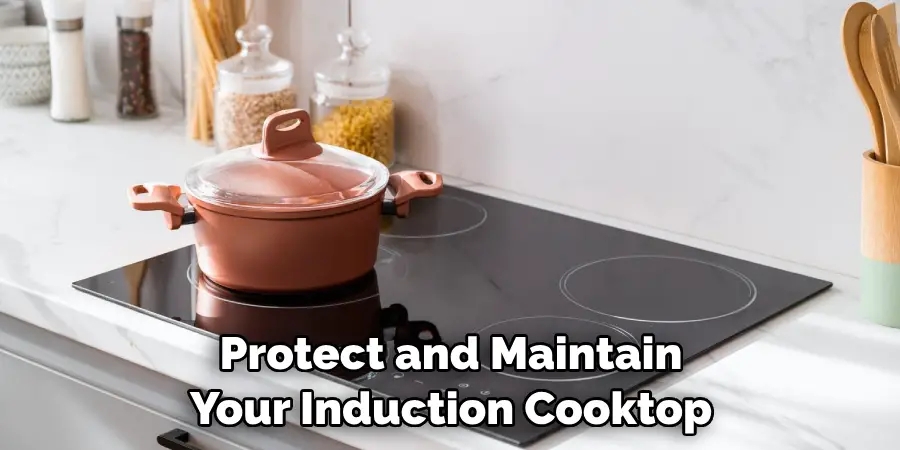
Implementing Cleaning and Maintenance Practices
To effectively implement the cleaning and maintenance practices outlined above, create a regular cleaning schedule that aligns with your cooking habits and the frequency of cooktop use.
This could mean performing a quick wipe-down after each use to remove immediate spills or residue, coupled with a more thorough cleaning once a week to address any accumulated grime or stains.
Additionally, make it a habit to inspect your cooktop regularly for any signs of wear or damage, such as scratches or cracks, which might necessitate a more detailed maintenance approach or professional repair.
Incorporating these practices into your daily routine can greatly enhance the longevity of your induction cooktop, ensuring it remains in top condition for years to come. It’s also beneficial to keep a small stock of the recommended cleaning supplies and tools in close proximity to your cooking area to facilitate quick clean-ups.
Remember, consistent care not only preserves the appearance and functionality of your induction cooktop but also contributes to a safe and enjoyable cooking environment.
Proper Placement and Use of Cookware Protection Accessories
To safeguard your induction cooktop from potential damage and extend its lifespan, proper placement and usage of cookware protection accessories are essential.
One effective strategy is the utilization of cookware protection mats, which are designed to sit between the cooktop and your pots or pans. These mats, often made from silicone or other heat-resistant materials, not only prevent scratches and nicks caused by direct contact with cookware but also help in evenly distributing heat.
Ensure that any protection mat used is compatible with induction cooking and does not hinder the cooktop’s magnetic field. Place the mat on the cooking zone before turning on the power, and always remove it immediately after cooking to avoid heat trapping, which could potentially harm the cooktop’s surface.
Additionally, invest in quality cookware with smooth bottoms, avoiding those with rough textures or sharp edges that can scratch the cooktop surface. Cookware with induction-compatible, flat bases ensure efficient heat transfer and reduce the risk of accidental sliding, further protecting the cooktop.
In summary, the judicious use of cookware protection accessories, alongside mindful handling of pots and pans, plays a crucial role in maintaining the pristine condition of your induction cooktop.
By incorporating these practices, users will not only enjoy the culinary benefits of their appliance but also contribute significantly to its longevity and aesthetic appeal.
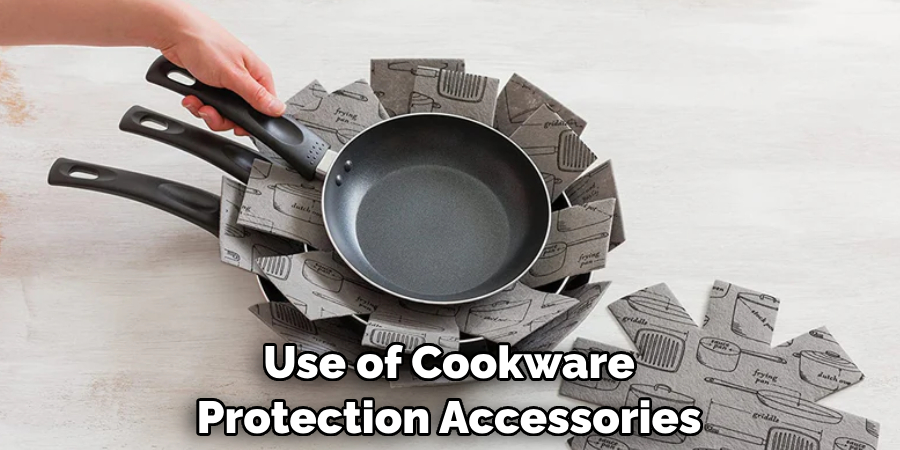
Conclusion
In conclusion, safeguarding your induction cooktop from scratches is crucial for maintaining its aesthetic appeal and performance over time. By following the tips and techniques outlined in this guide, you can effectively prevent scratches and prolong the lifespan of your cooktop.
Choosing smooth-bottomed cookware, using protective mats or liners, and practicing gentle cleaning and maintenance routines are key steps in preserving the surface of your induction cooktop.
Additionally, utilizing cookware protection accessories and being mindful of utensils and tools used on the cooktop surface can further reduce the risk of scratches. Thanks for reading, and we hope this has given you some inspiration on how to protect induction cooktop from scratches!

